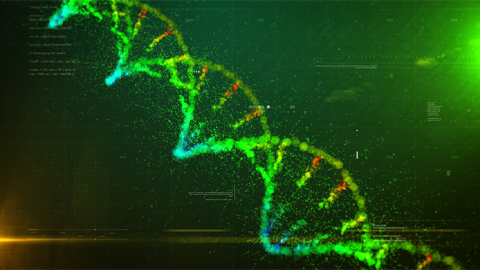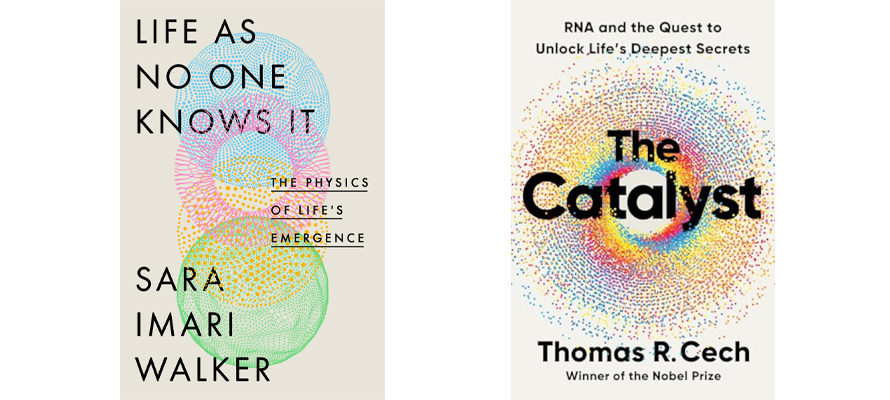Where do we search for the fundamental stuff of life?
While Gregor Mendel’s principles of genetic inheritance remain a staple of life sciences education in the United States, the 2024 store shelves are now lined with popular science books that tell us that our old pictures of the biological world ain’t what they used to be. Modern biology has threatened to turn much of what we’ve learned about biology on its head. All of a sudden, we are losing faith that the gene is the sole dictator of traits and fates. We learn in parallel that the evolutionary history of Homo sapiens isn’t what we thought a decade ago, all while synthetic biology (where molecular biology is used to build and design molecules and organisms) continues to explore the boundaries of living and nonliving. New discoveries complicate simple narratives for how it all works.

In the face of this, two new books — Sara Imari Walker’s “Life as No One Knows It: The Physics of Life’s Emergence” and Thomas Cech’s “The Catalyst: RNA and the Quest to Unlock Life’s Deepest Secrets” — offer original and much different (even if not conflicting) perspectives on how to construct a new picture of life. In Walker’s world, life has unique features that require brand new theoretical tools for us to properly comprehend. Cech offers that biology’s defining engine is not new at all but has been sitting under our noses (and inside our cells) all along. In sum, they capture the exuberance that lives in the various questions on the origins of life and what we can learn from exploring it. The study of the beginnings of life on Earth has now emerged, in my view, from a field dominated by speculative theories to one populated by large data sets, new technologies, and sophisticated theories. Indeed, Walker’s and Cech’s books are a sign that the quasi-race to understand what makes life work might be a fertile expanse for scientific theory and empirical discovery.
Walker is a theoretical physicist who has built an international reputation for her work in astrobiology and questions related to the origins of life. In her book, she lays out a provocative argument that the standard set of theories that we use to describe matter and forces are insufficient for understanding what, and why, life is. As chemist Lee Cronin has pointed out, the study of the origins of life doesn’t fit into current paradigms, but it is on the precipice of radical change, one that will doubtlessly be fomented by brand new theories.
Walker explains why asking how life on Earth began is such an important question: “Solving it will open new ways of thinking that start to unlock the other (perhaps harder) hard problems.”

In “Life as No One Knows It,” Walker questions our reliance on the notion that life is just another manifestation of the same-old biology, chemistry, and physics theories and methods. She spends significant time on an idea that she helped to pioneer called assembly theory. It proposes that living matter has an organizational structure that can be computed from its parts. That is, if we identify an object, we have a means through which we can measure whether that object is part of, or the product of, a biological process. The theory applies modern physics to understanding what life might look like: It is quantitative and agnostic to our earthly (and biased) definitions of biology.
Cech’s “The Catalyst” fits a mold of the grand science book of yesteryear: A highly successful and established scientist (in this case, one who shared the 1989 Nobel Prize in Chemistry) writes a grand book related to the ideas on which they built their reputation, adding some bolder claims. At best, these books can take us inside the mind and experiences of the people who changed our picture of nature. At worst, this style of book can suffer from an author unaware of their limitations (a form of the Dunning-Kruger effect) or an editor too afraid to tell them. Thankfully, “The Catalyst” is closer to the former: a measured treatise on the centrality of RNA in the living world. This includes a detailed history of our modern understanding of RNA — not written by a historian, but by one of RNA’s most respected advocates.
The messages of the books are so different that we need not contrive a conflict: Walker is a physicist talking about fundamental theories on what a living thing is; Cech is highlighting the history and importance of one of molecular biology’s uncredited main characters. However, the projects are useful to describe in tandem because they are a sign of the times: We have entered an era in which we are beginning to recognize that enormous data collection efforts alone will not solve fundamental questions about life. Proper answers will require some abstract theorizing and old-fashioned peering inside of cells.
Cech’s book highlights the many triumphs that have come from investigation into how RNA works. Unsurprisingly (and thankfully) Cech highlights the discovery of the technology that powered the SARS-CoV-2 vaccines, one of the most impressive scientific exercises in recent memory. And it was the work of Katalin Karikó and Drew Weissman that helped spawn this movement by unlocking the potential of mRNA to serve as the basis for a new generation of vaccines. The pair was eventually awarded the Nobel Prize in Physiology or Medicine in 2023.
Similarly, Cech highlights how drugs that target RNA within cells are already generating promising directions for disease therapeutics. It may very well be true that the future of therapeutics may hinge on unlocking the unmatched chemical fungibility of RNA, not unlike how its powers were unlocked in the development of the SARS-CoV-2 vaccine. The chapter entitled “Origins” takes on origins-of-life questions most directly. And maybe surprisingly, Cech does not offer a vigorous defense of the controversial RNA world hypothesis, which posits that self-replicating RNA existed before DNA or proteins. Further, he expresses general unease about origins-of-life research, writing that he believes the field “is sometimes spun in speculative directions that verge on hype.”
While Cech is skeptical, Walker thrives in the speculative space. She argues that new rules for how life works are not confined to any particular sort of biochemistry but rather arise from the manner in which life is constructed around the known and, more provocatively, the unknown universe. In addition to her own work on assembly theory, Walker guides us through many different implications of her expanded take on theories of life, including the assembly of living matter from non-living parts.
She anticipates the natural questions that arise by discussing the implications for extraterrestrial life in a chapter appropriately entitled “Aliens.” Armed with her perspective, we now have a different means of considering what alien life will look like, and how to find it.
She insightfully highlights that first contact with aliens will not be “an event, or even a piece of data.” Rather, it will be a “cultural transformation in our understanding of and explanations for what life is.” That is, Walker suggests that simply locating something that appears like a living thing outside of Earth is not nearly enough. A true understanding of unearthly life will require developing robust theories on what life is before the presumptive first-contact event.
Both books offer useful messages that resonate with different parts of my scientific personality. In “Life as No One Knows It,”
Walker argues that we should not be afraid to pursue new theoretical ideas that may come from nontraditional sources or that may not look anything like the theories of yesterday. As an evolutionary theorist, I have long felt uneasy with my allegiance to certain conventions, some of which are doubtlessly colored by historical biases. Walker encourages us to open up possibilities for thinking about what life is, and how it is made.
In “The Catalyst,” Cech similarly encourages us to depart from tradition, but his suggestion is much more corporeal: Unlocking the biochemical generalism of RNA might be the key to understanding how life works, and for how to make it work better. Cech reminds us that the analogy of DNA as the blueprint — one that many are becoming increasingly critical of — may have distracted biologists across fields from a greater focus on RNA. Thankfully, it isn’t too late: RNA’s function as an enzyme, its potential for vaccines, and its role in gene editing might be only the beginning.
Both Walker and Cech have created the unusual but pleasant effect of offering hopeful takes on how to study the living universe. Possibility for breakthroughs on life’s fundamentals exists for scientists trained in various traditions: Whether you tirelessly tinker in the lab with the goo of Earth’s living things or prefer to confine your tools to the chalkboard or computer, there is a role for you in our eternal quest to understand the what, why, and how of life — the universe's most compelling organization of matter and information.
This article is republished from Undark. Read the original article.

Enjoy reading ASBMB Today?
Become a member to receive the print edition four times a year and the digital edition monthly.
Learn moreGet the latest from ASBMB Today
Enter your email address, and we’ll send you a weekly email with recent articles, interviews and more.
Latest in Opinions
Opinions highlights or most popular articles

Sketching, scribbling and scicomm
Graduate student Ari Paiz describes how her love of science and art blend to make her an effective science communicator.

Embrace your neurodivergence and flourish in college
This guide offers practical advice on setting yourself up for success — learn how to leverage campus resources, work with professors and embrace your strengths.

Survival tools for a neurodivergent brain in academia
Working in academia is hard, and being neurodivergent makes it harder. Here are a few tools that may help, from a Ph.D. student with ADHD.

Hidden strengths of an autistic scientist
Navigating the world of scientific research as an autistic scientist comes with unique challenges —microaggressions, communication hurdles and the constant pressure to conform to social norms, postbaccalaureate student Taylor Stolberg writes.

Black excellence in biotech: Shaping the future of an industry
This Black History Month, we highlight the impact of DEI initiatives, trailblazing scientists and industry leaders working to create a more inclusive and scientific community. Discover how you can be part of the movement.

Attend ASBMB’s career and education fair
Attending the ASBMB career and education fair is a great way to explore new opportunities, make valuable connections and gain insights into potential career paths.

